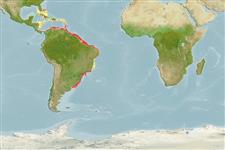>
Eupercaria/misc (Various families in series Eupercaria) >
Sciaenidae (Drums or croakers)
Etymology: Micropogonias: Greek, mikros = small + greek, pogon = beard (Ref. 45335).
Issue
The species Micropogonias opercularis (Quoy & Gaimard, 1825) is considered as valid in Eschmeyer (CofF ver. Jul. 2010: Ref. 84883) according to López et al. (2002: Ref. 80900).
Environment: milieu / climate zone / depth range / distribution range
Écologie
marin; saumâtre démersal; océanodrome (Ref. 51243); profondeur ? - 60 m (Ref. 9626), usually 20 - 40 m (Ref. 9626). Subtropical; 27°N - 36°S, 84°W - 34°W (Ref. 54591)
Western to Southwest Atlantic: Greater Antilles and from Costa Rica to Argentina (Ref. 9626). Also reported in Nicaragua (Ref. 13613). Also reported in Brazil (Ref. 118626).
Length at first maturity / Taille / Poids / Âge
Maturity: Lm 30.6 range ? - ? cm
Max length : 60.0 cm SL mâle / non sexé; (Ref. 27363); common length : 45.0 cm SL mâle / non sexé; (Ref. 27363); poids max. publié: 55.30 g (Ref. 118626); âge max. reporté: 7 années (Ref. 27)
Épines dorsales (Total) : 11; Rayons mous dorsaux (Total) : 26 - 30; Épines anales: 2; Rayons mous anaux: 7 - 9. Body silvery with a golden cast, back greyish, with distinct oblique dark streaks along scale rows extending to much below lateral line; spinous dorsal without small dark dots (Ref. 27363).
Found over muddy and sandy bottoms in coastal waters and in estuaries where the nursery and feeding grounds are located. Adults form schools. Feeding habits vary with ontogenic development and season; juveniles feed on benthic migratory crustaceans and sessile boring mollusks while adults are benthos-feeders and occasionally capture fish (Ref. 27). Undergoes seasonal migration. An important food fish which is usually marketed fresh and salted.
Isaac, V.J., 1988. Synopsis of biological data on the whitemouth croaker, Micropogonias furnieri (Desmarest, 1823). FAO Fish. Synop. (150). (Ref. 27)
Statut dans la liste rouge de l'IUCN (Ref. 130435)
Menace pour l'homme
Harmless
Utilisations par l'homme
Warning: mysqli::__construct(): (HY000/1040): Too many connections in /var/www/html/includes/func_getlabel.php on line 46
Can't connect to MySQL database (fbapp). Errorcode: Too many connections
